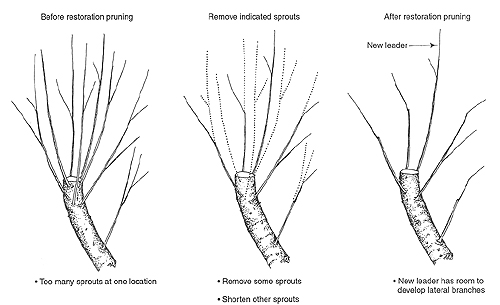Home > Pruning shade trees > Restoration pruning > Removing and reducing competing sprouts
Removing and reducing competing sprouts
Many branches and trunks sprout new shoots in response to the foliage and branch lose and the twisting that occurs in storms. These should be allowed to grow for one or more years until the tree appears to be recovering. Then, remove about one-third and reduce about one-third of the sprouts leaving those that remain to become the new branches.
Remove and reduce those that appear to be weak or cracked or have other defects. This improves the structure of the tree by spacing branches so they do not touch and reduces potential hazards. Shorten about one-third of the sprouts, remove another third and leave the remaining third. The remaining third should be well connected, free of damage, spaced apart, and should not be growing parallel to each other.
The goal on upright broken stems like the one pictured below is to guide one sprout to replace the broken stem. The weakly attached sprout will eventually increase in size and close over the pruning cut making the connection stronger.

Figure shows the process of improving structure on a damaged upright trunk or branch.
See animation of a restoring structure to a horizontal branch.

